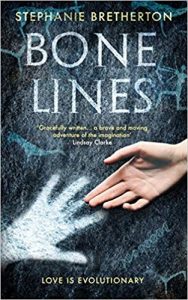‘Attention’ Seeking: Where Does Inspiration Come From?
 Authors are often asked a number of challenging questions. From “have you written anything I might be familiar with,” to “what is your book about” (um…how long have got?) and apart from honing our ‘elevator pitch’ skills, we must sometimes delve into the realms of the esoteric when asked, “where does your inspiration come from?”
Authors are often asked a number of challenging questions. From “have you written anything I might be familiar with,” to “what is your book about” (um…how long have got?) and apart from honing our ‘elevator pitch’ skills, we must sometimes delve into the realms of the esoteric when asked, “where does your inspiration come from?”
That question regularly comes up when people learn about the thought-provoking themes in my book, Bone Lines, which has a dual narrative set in prehistoric times and in the modern day and which explores themes from science to spirituality, asking what lies at the heart of being human.
There is no straightforward answer to inspiration. That elusive blessing from the muse to which all artists appeal can be lightning in a bottle, arriving at random via a range of stimuli. Nevertheless, I have found a number of ways to gently encourage and make space for the creative ‘state of grace.’ Some of that is as practical as good preparation – for example, keeping a notebook handy for when that idea strikes (though more often, now, I dictate into my phone). However, it’s important not to despair if the ideas aren’t coming.
Just do it… (but don’t forget to stop and do nothing.)
I think of inspiration as a muscle to be exercised and coaxed into action. And one way is simply to start writing – anything, just turn on that tap and let the words flow out. But ‘freestyle’ isn’t always going to give shape to a story, or make sense of it.
In that regard, a regular input of ‘Information’ is key (though, it’s important to be discerning about what you are taking in.) I tend to source my data in the classical ways such as reading about science and history, or seeking out a good documentary, but also through a kind of environmental ‘osmosis.’
For me, this works best by getting out into nature and grounding myself , engaging every sense and trying to feel fully present in any situation, whether that’s walking in the woods, or on a hillside, or along the coast. I tend to have a bullet-speed thought train but I find it easier to both quiet and open the mind, to allow observations and realisations to arise, in natural surroundings.
This process was vital for the creation of ‘Sarah’ – my prehistoric shaman character in Bone Lines – who survives by being completely in tune with her landscape, seen and unseen. (Although, having said that, I do very much feel that Sarah created herself, as once she began to take form she told me who she was and what she would do.)
The practice also helped, however, when developing the book’s modern day character, who (like me) often escapes to London’s Hampstead Heath. This seeking out of the natural world and becoming ‘quiet’ within it has now become a conscious ritual, but I believe it’s always been a powerful inclination for me. As I child I was more than happy to spend time alone – and hours of that was in the water (even if under a parent’s watchful eye.).
It’s all in the mind… (or down the rabbit hole.)
In adulthood, the practice of meditation and mindfulness has been enormously beneficial in creating the space for ideas and insights to form. I now meditate almost every morning. But that ‘headspace’ doesn’t have to be limited to a formal procedure, as once you start to develop the skills of mindfulness, you can bring them into play in almost any situation (admittedly, many situations still prove challenging to me!)
Perception is also key. Much as I love to immerse myself in the ‘natural’ world I try to remember that human beings are also ‘nature’ and so the practice of observing one’s own thoughts, feelings and responses – as well as paying attention to others – is vital to the writer.
On the one hand it’s important to take note, examine and dig down, but on the other, to let the mind wander in a creative way. I was often accused as a child of being a ‘daydreamer’ and I think most writers cannot resist following those imaginary ‘what ifs’ all the way down the rabbit hole to wherever they may lead (whether or not this evolves into a narrative).
Watch, listen, learn… (but it’s good to talk, too.)
Once you have that flash of inspiration, you need to capture, explore and measure it. Test it against reality in terms of whether it works as – or for – a story. Of course, a balance needs to be achieved. If you spend too much time analysing or ruminating you can lose that mercurial sense of poetry, of the mysterious and the wondrous… the elemental soul of storytelling. (I lesson I am still learning in my own writing.)
People-watching (and culture-watching) is another fine way to encouraging the muse, but so is engagement. Writers are often introverted, even solitary characters by nature and that shyness can mean not making oneself an obvious or active part of a scene… and ‘invisibility’ can be useful. But so can starting or accepting a conversation, however excruciating ‘making small talk’ might feel. As well as reconnecting you to others, you never know what might form the basis for a supporting character, or suggest some authentic ‘backstory’ or the descriptive details that can make a character come to life.
It’s also important for a writer to interact with the wider culture, whether that’s the visual, performing, musical or literary arts, all of which work on the sensory system in magical ways, keeping responses fresh and alive. So, there’s a balance to be struck between engaging with the world – natural or cultural – and seeking out that much-needed stillness and silence, tuning out the noise, turning off the screens, putting aside any ‘fear of missing out’ and letting the mind simply ‘be.’
Stay focussed… (but don’t forget to forget about all that.)
Ultimately, I feel, the paradox of inspiration is about first paying close attention – and then letting your mind wander. This sense of ‘allowing’ is something I tried to tap into with my characters in Bone Lines. My prehistoric heroine lives intuitively in the present, at one with her world yet always ready to adapt, while the modern day doctor ties herself down in mental knots. But also, the very process of imagining the person whose bones she is studying has a dramatic and positive effect on her, drawing her out of her ruminations and attachment to her own past.
A writer then, has to become an ‘attention seeker’ – in the best possible way. The root of the word inspiration relates to receiving or inhaling the ‘spirit.’ To tap into its gifts, then, it’s essential to stop, breathe, observe, listen… and then let yourself lucidly dream.
—
Born in Hong Kong to expats from Liverpool (and something of a nomad ever since), Stephanie is based in London but manages her sanity by escaping to any kind of coast. Before returning to her first love of writing fiction, Stephanie spent many years pursuing alternative forms of storytelling, from stage to screen and media to marketing. Meanwhile, an enduring love affair with words has led her down many a wormhole on the written page.
Drawn to what connects rather than separates, Stephanie is fascinated by the spaces between absolutes and opposites, between science and spirituality, nature and culture. This lifelong curiosity – and occasional conflict – has been channelled into her debut novel, Bone Lines, and into short stories, poems and various works in progress. This includes ideas for the continuation of the Children of Sarah series, of which Bone Lines is the first story.
http://stephaniebretherton.com/
twitter: @BrethertonWords
BONE LINES, Stephanie Bretherton
 A young woman walks alone through a barren landscape in a time before history, a time of cataclysmic natural change. She is cold, hungry and with child but not without hope or resources. A skilful hunter, she draws on her intuitive understanding of how to stay alive… and knows that she must survive.
A young woman walks alone through a barren landscape in a time before history, a time of cataclysmic natural change. She is cold, hungry and with child but not without hope or resources. A skilful hunter, she draws on her intuitive understanding of how to stay alive… and knows that she must survive.
In the present day, geneticist Dr Eloise Kluft wrestles with an ancient conundrum as she unravels the secrets of a momentous archaeological find. She is working at the forefront of contemporary science but is caught in the lonely time-lock of her own emotional past.
Bone Lines is the story of two women separated by millennia yet bound by the web of life. This intriguing tale of love and survival, of courage and the quest for wisdom also explores the nature of our species and asks what lies at the heart of being human.
Gracefully written… a brave and moving adventure of the imagination. Lindsay Clarke, author of The Chymical Wedding
A monument to the timelessness of human nature, and a work of art… a masterpiece of pacing. Bretherton ignites her characters with a life, complexity, a personality with which any number of readers will identify and empathise with. Naomi Moore, Editor, New Orbit literary magazine
Bretherton weaves a cat s cradle of human history, from the panoramic overview to day-to-day existence. An accomplished debut… one to watch. Su Bristow, author of Sealskin
“A brilliant, genre-defying read, Bone Lines deftly unravels the wonder of oneness.” Barbara Bos, Editor, Women Writers, Women s Books.
Compelling… the story drew me in completely… a fascinating read. Cheryl Morgan-Muir, book blogger
BUY THE BOOK HERE
Category: How To and Tips






























